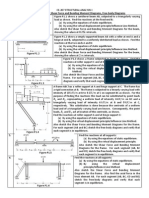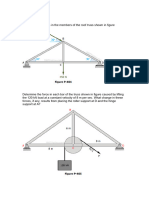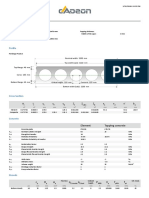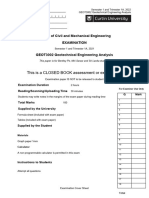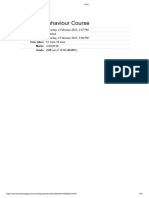Practice Problems 14: Influence Line
Practice Problems 14: Influence Line
Uploaded by
Mikhael Wakin RodriguezCopyright:
Available Formats
Practice Problems 14: Influence Line
Practice Problems 14: Influence Line
Uploaded by
Mikhael Wakin RodriguezOriginal Title
Copyright
Available Formats
Share this document
Did you find this document useful?
Is this content inappropriate?
Copyright:
Available Formats
Practice Problems 14: Influence Line
Practice Problems 14: Influence Line
Uploaded by
Mikhael Wakin RodriguezCopyright:
Available Formats
Practice Problems 14
INFLUENCE LINE
9.1 Draw the influence line for the shear force and moment at a section n at the midspan of
the simply supported beam shown in Figure P9.1.
Fig. P9.1. Simply supported beam.
9.2 Draw the influence lines for the reaction at A and B and the shear and the bending
moment at point C of the beam with overhanging ends, as shown in Figure P9.2.
Fig. P9.2. Beam with overhang.
9.3 Draw the influence line for the reactions at the support of the cantilever beam shown
in Figure P9.3.
Fig. P9.3. Cantilever beam.
9.4 Draw the influence line for the support reactions at B and D and shear and bending
moments at section n of the beam shown in Figure 9.4.
Fig. P9.4. Beam
9.5 Draw the influence lines for support reactions at C and D and at point B of the compound
beam shown in Figure P9.5.
Fig. P9.5. Compound beam.
9.6 Draw the influence lines for the shear force and moment at sections ns and k of the
compound beam shown in Figure P9.6.
Fig. P9.6. Compound beam.
9.7 Determine the absolute maximum bending moment in a 65 ft-long simply supported
girder bridge subjected to a moving truck loading, as shown in Figure P9.7.
Fig. P9.7. Simply supported girder bridge.
9.8 Determine the absolute maximum bending moment in a 12 m-long simply supported
girder bridge subjected to a moving truck loading, as shown in Figure P9.8.
Fig. P9.8. Simply supported girder bridge.
9.9 Determine the absolute maximum bending moment in a 40 ft-long simply supported
girder bridge subjected to a moving truck loading, as shown in Figure P9.9.
Fig. P9.9. Simply supported girder bridge.
9.10 Determine the absolute maximum bending moment in a 14 m-long simply supported
girder bridge subjected to a moving truck loading, as shown in Figure P9.10.
Fig. P9.10. Simply supported girder bridge.
9.11 Draw the influence lines for the moment at B and the shear force in panel CD of the
floor girder shown in Figure P9.11.
Fig. P9.11. Floor girder.
9.12 Draw the influence lines for the moment at C and the shear force in panel BC of the
floor girder shown in Figure P9.12.
Fig. P9.12. Floor girder.
9.13 Draw the influence lines for the moment at B and the shear in panel CD of the floor
girder shown in Figure P9.13.
Fig. P9.13. Floor girder.
9.14 Draw the influence lines for the moment at D and the shear force in panel DE of the
floor girder shown in Figure P9.14.
Fig. P9.14. Floor girder.
9.15 Draw the influence lines for the moment at D and the shear force in panel AB of the
floor girder shown in Figure P9.15.
Fig. P9.15. Floor girder.
9.16 Draw the influence lines for the forces in members CD, CF, and GF as a unit load
moves across the top of the truss, as shown in Figure P9.16.
Fig. P9.16. Truss.
9.17 Draw the influence lines for the forces in members DE, NE, and NM as a unit live load is
transmitted to the top chords of the truss, as shown in Figure P9.17.
Fig. P9.17. Truss.
9.18 Draw the influence lines for the forces in members DE, DH, IH, and HG as a unit live
load is transmitted to the bottom chords of the truss, as shown in Figure P9.18.
Fig. P9.18. Truss.
9.19 Draw the influence lines for the forces in members BC, BF, FE, and ED as a unit load
moves across the bottom chords of the truss, as shown in Figure P9.19.
Fig. P9.19. Truss.
You might also like
- Base Plate LSD SubramanianDocument20 pagesBase Plate LSD SubramanianShakil AkhterNo ratings yet
- Am 4Document3 pagesAm 4Mahesh MeenaNo ratings yet
- Practice Set 4 - SolnDocument14 pagesPractice Set 4 - Solngewemac960No ratings yet
- Module1 - Set 1bDocument5 pagesModule1 - Set 1bindhubalab200413chNo ratings yet
- Assignment 1Document5 pagesAssignment 1Mansimran Singh-iit GuwahatiNo ratings yet
- Structural Analysis Problems For PracticeDocument10 pagesStructural Analysis Problems For PracticePradyumnaSadgir100% (1)
- Module1 - Set 2bDocument4 pagesModule1 - Set 2bindhubalab200413chNo ratings yet
- Assignment 09ADocument3 pagesAssignment 09Ayagrazz33No ratings yet
- The PinDocument7 pagesThe PinAlyssa AtienzaNo ratings yet
- Sec Problem SetDocument23 pagesSec Problem Setbensonsevilla21No ratings yet
- Applied Mechanics I Tutorials and AssignmentDocument34 pagesApplied Mechanics I Tutorials and AssignmentaayushNo ratings yet
- Tutorial SheetDocument4 pagesTutorial SheetjaiNo ratings yet
- Unit 9 - Foundation DesignDocument18 pagesUnit 9 - Foundation DesignDennis DorcooNo ratings yet
- CENG198 CE Competency Appraisal IllDocument4 pagesCENG198 CE Competency Appraisal IllJeric DinglasanNo ratings yet
- Structural Analysis & Design-I CE-311 Course Instructor: Dr. Nusrat HoqueDocument23 pagesStructural Analysis & Design-I CE-311 Course Instructor: Dr. Nusrat HoqueMehedi Hasan ShawonNo ratings yet
- Checklist 01 - Unit 01 - SFD BMDDocument17 pagesChecklist 01 - Unit 01 - SFD BMDRefai SayyadNo ratings yet
- PDFDocument70 pagesPDFRen RenNo ratings yet
- Section: R Assignment No. Date of Assignment - /9/2015 Date of Submission - /9/2015Document3 pagesSection: R Assignment No. Date of Assignment - /9/2015 Date of Submission - /9/2015Bharat SharmaNo ratings yet
- MEMB123 Final Examination Paper Sem 2-09-10 FinalDocument6 pagesMEMB123 Final Examination Paper Sem 2-09-10 FinalMei QiiNo ratings yet
- Influence Lines 3.JntDocument7 pagesInfluence Lines 3.JntShiham BadhurNo ratings yet
- Unit 1 - Assignment 01Document15 pagesUnit 1 - Assignment 01Refai SayyadNo ratings yet
- Assignment T5Document9 pagesAssignment T5Shuaib AhmadNo ratings yet
- Assignment T5Document9 pagesAssignment T5Shuaib AhmadNo ratings yet
- 2 0 Introduction-Concept of StressDocument7 pages2 0 Introduction-Concept of Stressdarshan rathodNo ratings yet
- Shear & Moment in Beams: Definition of A BeamDocument68 pagesShear & Moment in Beams: Definition of A BeamMelian RebamontanNo ratings yet
- Unit-2 Shear Force and Bending MomentDocument7 pagesUnit-2 Shear Force and Bending MomentMouli Sankar100% (1)
- Assignment01 - Mechanic SDocument4 pagesAssignment01 - Mechanic SSunil TamangNo ratings yet
- ime m1 t2Document2 pagesime m1 t2legendram008No ratings yet
- Ce234 Topic 09-10Document58 pagesCe234 Topic 09-10Nicholas Bonn SingNo ratings yet
- Assignment 3: Moment and Equivalent System of Forces Due Date: July 29, 2019 (Shrawan 13)Document5 pagesAssignment 3: Moment and Equivalent System of Forces Due Date: July 29, 2019 (Shrawan 13)Ganga DahalNo ratings yet
- Shear and Moment in BeamsDocument60 pagesShear and Moment in BeamsAthena YoungNo ratings yet
- Birla Institute of Technology and Science, PilaniDocument5 pagesBirla Institute of Technology and Science, PilaniRohit KumarNo ratings yet
- Assisgnment 2Document5 pagesAssisgnment 2atharvnetke9No ratings yet
- Paper 1 12546 997Document17 pagesPaper 1 12546 997panger moooNo ratings yet
- A2142851720 - 18537 - 9 - 2019 - Tutorial Sheet 1Document5 pagesA2142851720 - 18537 - 9 - 2019 - Tutorial Sheet 1harshitNo ratings yet
- Assignment 1 MOSDocument47 pagesAssignment 1 MOSGaurav RajNo ratings yet
- Spandrel Flexural Design: Technical NoteDocument10 pagesSpandrel Flexural Design: Technical Notetomxxx34No ratings yet
- Torsion of Circular ShaftsDocument26 pagesTorsion of Circular ShaftsNaveen Kumar0% (1)
- E Mech 22-23Document17 pagesE Mech 22-23Subrata MondalNo ratings yet
- Mechanics LongDocument5 pagesMechanics Longsivaraju8No ratings yet
- Week 1 AssignmentDocument3 pagesWeek 1 Assignmentyash guptaNo ratings yet
- School of Mechanical Engineering, Kiit University Assignment 1 Subject: Engineering Mechanics DueonDocument3 pagesSchool of Mechanical Engineering, Kiit University Assignment 1 Subject: Engineering Mechanics Dueonmantra20100% (3)
- GEG 113 SlidesDocument47 pagesGEG 113 SlidesOlajuwonNo ratings yet
- Bolt Design For Repeated LoadingDocument13 pagesBolt Design For Repeated Loadingchandrasingh4564No ratings yet
- Design and Analysis of Small Container Vessel For Indian PortsDocument23 pagesDesign and Analysis of Small Container Vessel For Indian PortsRefai SayyadNo ratings yet
- Pca Circular Concrete TanksDocument32 pagesPca Circular Concrete TanksFeliciano Esteban DominguezNo ratings yet
- Wrap Around Gusset PDFDocument25 pagesWrap Around Gusset PDFmuralihare100% (1)
- Moment Baseplate DesignDocument10 pagesMoment Baseplate DesignNeil JonesNo ratings yet
- Lecture 11-1 Bases by H.J. MtyanaDocument29 pagesLecture 11-1 Bases by H.J. MtyanaHarold Jackson Mtyana100% (1)
- Tutorial Sheet 1 PDFDocument5 pagesTutorial Sheet 1 PDFSuhail KhanNo ratings yet
- 4.1 Tutorial Sheet 1 PDFDocument5 pages4.1 Tutorial Sheet 1 PDFManish JainNo ratings yet
- Tutorial sheet 1: (R=179 N and α=104.5° in third quadrant from x-axis)Document5 pagesTutorial sheet 1: (R=179 N and α=104.5° in third quadrant from x-axis)rishav singhNo ratings yet
- Tutorial sheet 1: (R=179 N and α=104.5° in third quadrant from x-axis)Document5 pagesTutorial sheet 1: (R=179 N and α=104.5° in third quadrant from x-axis)PuneetNo ratings yet
- Tutorial Sheet 1 PDFDocument5 pagesTutorial Sheet 1 PDFravi gargNo ratings yet
- Handbook of Railroad Construction; For the use of American engineersFrom EverandHandbook of Railroad Construction; For the use of American engineersNo ratings yet
- A Little Book of Making Tools and Equipment for the Studio: Includes Instructions for Making a Printing Press, Line Printing Blocks, Rubber Stamp Making, Stencil Cutting and StencillingFrom EverandA Little Book of Making Tools and Equipment for the Studio: Includes Instructions for Making a Printing Press, Line Printing Blocks, Rubber Stamp Making, Stencil Cutting and StencillingNo ratings yet
- Scientific American Supplement, No. 611, September 17, 1887From EverandScientific American Supplement, No. 611, September 17, 1887No ratings yet
- Lecture Notes On STRENGTH OF MATERIALSDocument94 pagesLecture Notes On STRENGTH OF MATERIALSAmumpeire SamwelNo ratings yet
- D 1143 - 81 R94 AstmDocument4 pagesD 1143 - 81 R94 AstmAbdullah100% (1)
- Cosfb - Composite Slim-Floor Beam: Experimental Test Campaign and EvaluationDocument15 pagesCosfb - Composite Slim-Floor Beam: Experimental Test Campaign and EvaluationDima OvsiiNo ratings yet
- Mechanics of Materials: C. Blanco, J.M. Cabrero, A. Martin-Meizoso, K.G. GebremedhinDocument7 pagesMechanics of Materials: C. Blanco, J.M. Cabrero, A. Martin-Meizoso, K.G. GebremedhinPK IMM FEB Bidang KaderNo ratings yet
- RCDCODEDocument6 pagesRCDCODEGiemhel GeleraNo ratings yet
- Sample Reviewer GEODocument10 pagesSample Reviewer GEOOwen Radaza PiranteNo ratings yet
- Strut BucklingDocument15 pagesStrut BucklingnicholasNo ratings yet
- Element Topping Concrete: A I y y y Z Z Z e e E' BDocument6 pagesElement Topping Concrete: A I y y y Z Z Z e e E' BAistė VaitkuvienėNo ratings yet
- Assignment 2 (Chap 3 and 4) - Marwan Alaa 100063027Document54 pagesAssignment 2 (Chap 3 and 4) - Marwan Alaa 100063027marwan alaaNo ratings yet
- Strap Footing Design: ASDIP Foundation 4.4.2Document4 pagesStrap Footing Design: ASDIP Foundation 4.4.2jhon j gomezNo ratings yet
- Bolted and Riveted ConnectionsDocument42 pagesBolted and Riveted Connectionsbayang000No ratings yet
- Nozzle Load T1011 12Document12 pagesNozzle Load T1011 12koyahassanNo ratings yet
- Solid 187Document9 pagesSolid 187niteen_mulmule485No ratings yet
- Strength and Failure CriteriaDocument29 pagesStrength and Failure CriteriaAndres RzNo ratings yet
- Elastic ModulusDocument4 pagesElastic ModulusValerio Jackson MelucciNo ratings yet
- Stability Analysis of Slope With Building LoadsDocument11 pagesStability Analysis of Slope With Building LoadsabdallahNo ratings yet
- ETABS 19.1.0-Design Details 2Document2 pagesETABS 19.1.0-Design Details 2Alejandro Tovar MolinaNo ratings yet
- Introduction To Column Buckling: ©teaching Resource in Design of Steel StructuresDocument35 pagesIntroduction To Column Buckling: ©teaching Resource in Design of Steel Structureshemant_durgawaleNo ratings yet
- Buckling Analysis Per Aisc 360-10Document2 pagesBuckling Analysis Per Aisc 360-10Christian LeobreraNo ratings yet
- Prediction of Nonlinear Soil ResponseDocument21 pagesPrediction of Nonlinear Soil ResponseSCNo ratings yet
- GEOT3002 IRIS Final ExamDocument5 pagesGEOT3002 IRIS Final ExamNeon LalNo ratings yet
- Steel Design PresentationDocument90 pagesSteel Design Presentationraghav abudhabiNo ratings yet
- Potable Water Tank Calculation PDFDocument37 pagesPotable Water Tank Calculation PDFboysitumeangNo ratings yet
- Ch17 ArchesDocument45 pagesCh17 ArchesErnie ErnieNo ratings yet
- Quiz PDFDocument47 pagesQuiz PDFusamaabid905No ratings yet
- Bearing Design Method BDocument38 pagesBearing Design Method BTeguh FahrezaNo ratings yet
- Calculation Sheet: Test Job Member Design For SB2Document2 pagesCalculation Sheet: Test Job Member Design For SB2bungykitNo ratings yet
- Chapter-3 Behaviour of Composite Deck: 3.1 GeneralDocument11 pagesChapter-3 Behaviour of Composite Deck: 3.1 GeneralraviciviltNo ratings yet
- The Effect of Shrinkage Cracks On The Load Bearing Capacity of Steel-Fibre-Reinforced Roller-Compacted - Concrete PavementsDocument27 pagesThe Effect of Shrinkage Cracks On The Load Bearing Capacity of Steel-Fibre-Reinforced Roller-Compacted - Concrete PavementsLouis KiwaNo ratings yet
- Design For ShearDocument19 pagesDesign For ShearMahmuddin AminNo ratings yet





